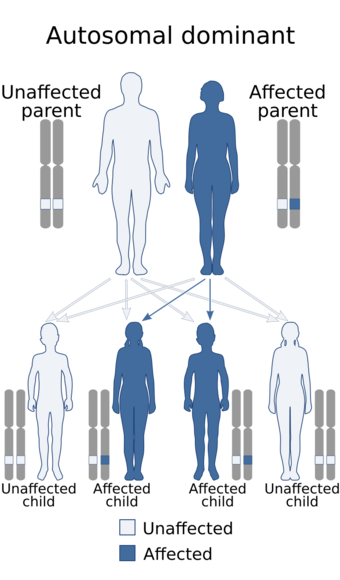Medicine:Bosch-Boonstra-Schaaf optic atrophy syndrome
| Bosch-Boonstra-Schaaf optic atrophy syndrome | |
|---|---|
| Other names | BBSOAS [1] |
 | |
| This condition is inherited via autosomal dominant manner | |
| Causes | mutations in the NR2F1 gene |
Bosch-Boonstra-Schaaf optic atrophy syndrome is a rare autosomally inherited condition characterised by developmental delay, intellectual disability and decreased visual acuity.[2][3][4]
Presentation
All patients described have suffered from developmental delay, intellectual disability (intelligence quotient range 48-74) and decreased visual acuity. Ocular abnormalities include small discs, pale discs, disc excavation, strabismus and latent nystagmus.
Other features of this condition are somewhat variable and include:
- Facial indicators
- Protruding ears
- Helical anomalies
- Small nasal ridge
- High nasal bridge
- Upturned nose
- Epicanthal folds
- Upslanting palpebral fissures
- Skeletal indicators
- Tapering fingers
- Hypotonia
Genetics
This condition is caused by mutations in the NR2F1 gene. This gene is located on the long arm of chromosome 5 (5q15) and encodes a protein that acts as a nuclear receptor and transcriptional regulator. The syndrome is inherited in an autosomal dominant fashion.[citation needed]
Management
There is no curative treatment known at present for his condition. Management is supportive.[citation needed]
Epidemiology
This condition is considered to be rare with fewer than 50 cases described in the modern literature.
History
This condition was first described in 2014.[5]
References
- ↑ "OMIM Entry – # 615722 – Bosch-Boonstra-Schaaf Optic Atrophy Syndrome; BBSOAS". https://omim.org/entry/615722. Retrieved 19 January 2020.
- ↑ Bosch DGM, Boonstra FN, Gonzaga-Jauregui C, Xu, M, de Ligt J, Jhangiani S, Wiszniewski W, Muzny DM, Yntema HG, Pfundt R, Vissers L E, Spruijt L, and 12 others. NR2F1 mutations cause optic atrophy with intellectual disability. American Journal of Human Genetics 94: 303-309
- ↑ Chen CA, Bosch DG, Cho MT7, Rosenfeld JA, Shinawi M, Lewis RA, Mann J, Jayakar P, Payne K, Walsh L, Moss T, Schreiber A, Schoonveld C, Monaghan KG, Elmslie F, Douglas G, Boonstra FN, Millan F, Cremers FP, McKnight D, Richard G, Juusola J, Kendall F, Ramsey K, Anyane-Yeboa K, Malkin E, Chung WK, Niyazov D, Pascual JM, Walkiewicz M, Veluchamy V, Li C, Hisama FM, de Vries BB, Schaaf C (2016)The expanding clinical phenotype of Bosch-Boonstra-Schaaf optic atrophy syndrome: 20 new cases and possible genotype-phenotype correlations. Genetics in Medicine. 18(11):1143-1150.
- ↑ Chen CA, Wang W, Pedersen SE, Raman A, Seymour ML, Ruiz FR, Xia A, van der Heijden ME, Wang L, Yin J, Lopez J, Rech ME, Lewis RA, Wu SM, Liu Z, Pereira FA, Pautler RG, Zoghbi HY, Schaaf CP (2019) Nr2f1 heterozygous knockout mice recapitulate neurological phenotypes of Bosch-Boonstra-Schaaf optic atrophy syndrome and show impaired hippocampal synaptic plasticity. Human Molecular Genetics. 2020;29(5):705-715. PMID 31600777. PMCID PMC7104670. doi 10.1093/hmg/ddz233
- ↑ Bosch DGM, Boonstra FN, Gonzaga-Jauregui C, Xu, M, de Ligt J, Jhangiani S, Wiszniewski W, Muzny DM, Yntema HG, Pfundt R, Vissers L E, Spruijt L, and 12 others. NR2F1 mutations cause optic atrophy with intellectual disability. American Journal of Human Genetics. 94: 303–309.
External links
 |

